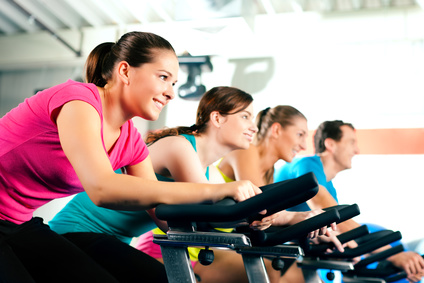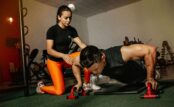
No pain no gain may resonate with the bodybuilding set, but it’s among the worst exercise tips if you’re working out with Irritable Bowel Syndrome. The same goes for colitis, acid reflux, Crohn’s and other gut diseases – a recent study found intense exercise can lead to gut damage and make symptoms worse if you’re prone to GI problems.
You can define ‘strenuous’ as 60% of your maximum intensity for roughly two hours, by the way. That’s about the amount of energy you’d use for cycling or running.
Make no mistake, you still want to exercise if you have IBS. In fact you need too – exercise helps with weight management, which helps lower IBS and related gut problems in people when done effectively. It’s just that you’ll want to do so strategically. In this article we’ll talk about exercise tips for people with IBS and gut disorders, and how to walk that sometimes fine line between helpful and harmful.
Study Links Intense Exercise to Gut Problems
The study, which was recently published online in the journal Ailmentary Pharamacology & Therapeutics, found the stress of prolonged, vigorous activity seems to shut down gut function.
That’s not surprising, said the study authors, who say the redistribution of blood away from the gut and toward working muscles creates gut cell injury. This can lead to cell death, leaky gut syndrome and systematic immune response.
They also note that risk of gut injury and impairment went up with exercise intensity. The more strenuous the workout, the more likely it was that gut problems occurred.
Two hours of strenuous seemed to be the tipping point, at 60% maximum intensity – be it cycling, running, or other activities that required similar effort.
For their methodology, the researchers analyzed eight previous studies that looked at this issue, which is called ‘exercise-induced gastrointestinal syndrome’. Two hours of strenuous seemed to be the tipping point, at 60% maximum intensity – be it cycling, running, or other activities that required similar effort.
Heat stress appeared to be an issue as well.
The most logical explanation for this link is that people with gut diseases may be at higher risk of health problems, the authors said. Doctors that observed the study agree with this, citing that normal blood flow to the GI tract is needed to oxygenate gut cells. In turn, this manages metabolism and keeps gut function in form.
With much less blood during exercise, patients can get gut inflammation and ‘leaky gut’ syndrome, in which gut toxins leak into systematic circulation.
Having said this, exercise is proven to help people with IBS. It helps patients manage weight and reduce obesity. The latter is linked to many GI diseases, including gall bladder disease, fatty liver disease, acid reflux and colon cancer, among others.
Regular exercise, when done moderately, also appears to lower risk of cardiovascular disease, type 2 diabetes and depression.
What the Researchers Suggest
The study authors suggest people with gut problems should drink plenty of water before and possibly eat a small amount of proteins and carbohydrates before and during their workout regimen.
You may also want to rest at various points during your workout and discuss any symptoms with your doctor. The latter is especially important – stomach pain is a sign of a potential issue that should be examined.

Notably too, the researchers suggest that patients should not take NSAIDs like ibuprofen or naproxen before working out. They also mention the low FODMAP diet may reduce gut problems because it’s rich in specific carbohydrates that pull water into the intestinal tract.
Speak with an experienced dietician before trying the FODMAP diet should this route be of interest to you.
Exercise Tips for Tummy Trouble
One of the most useful exercise tips for people with gut problems is to stay within their comfort zone. Going by this most recent study, that means no more that 60% of your maximum intensity. This applies to you in particular if you have:
Crohn’s Disease – This is an immune system condition characterized by inflammation of the GI tract. Symptoms include bleeding, diarrhea, belly pain and lack of appetite.
Ulcerative Colitis – This is similar to Crohn’s, but it’s limited to the colon. Colitis tends to cause more pain, greater bleeding and worse diarrhea (nice, huh?).
IBS – We’ve written about Irritable Bowel Syndrome extensively here at Natural Health Source. There is no inflammation involved with IBS, though it can make life very unpleasant – it’s a group of digestive symptoms and changes in bowel movements. IBS is constipation, diarrhea, bloating and a quick need to visit a toilet.
Reflux – Acid reflux is when stomach acid escapes through the valve that separates your stomach and esophagus. Think heartburn and swallowing problems, along with that gross taste you get when you throw up in your mouth,
The following exercise tips may help:
Exercise!
– This may sound counter-intuitive when you consider what we’ve just discussed, but exercise is essential for people with gut problems because it helps with weight loss and assists in a variety of ways. The key is to keep it moderate. Remember, keep it under 60% intensity if you have gut problems. Take breaks too, and drink plenty of water.
Talk to Others – You’re definitely not the only person on the planet with gut problems. It’s estimated that between 10 to 15% of folks in the US alone have the same issue. Keep an open dialogue with your doctor and speak with others at the gym or where you exercise. What exercise tips do they recommend? How do they cope with stress?

Stay Hydrated – Fluid intake is one of the best exercise tips out there for people with gut problems. Assuming your doctor clears it, drink plenty of water.
Choose Your Exercises – We’ll talk about some of the best and worst exercises for people with gut problems later in this article. As a general rule, however, you’re going to keep things light – at least while your stomach is acting up. That means CrossFit probably won’t happen while you’re in pain. Light exercises, like yoga, pilates, tai chi and barre classes may help.
Plan Ahead – Patients with IBS are used to planning their commute with toilets along the way. You should do the same. Be ready to dart to the toilet if your symptoms act up. Bring some toilet paper or wet wipes if you get diarrhea while exercising in the great outdoors.
Monitor How You’re Doing – Check in with yourself every 15 minutes. Talk to yourself – say something like “Now I pay much closer to my body and what it needs. I still have bad days, but now I’m in a much better position to ride them out. For example, I can walk instead of swimming.”
Feel free to exercise a little harder if your symptoms are behaving. You generally shouldn’t have a problem unless you become dehydrated or overdo it.
Have a Plan B – Be prepared to adapt if your symptoms flare up. Tell yourself you can ride a bike for example if you’re not up for a swim.
Listen To Your Body – Your body will tell you exactly how it feels. Listen to it – if you’re exhausted, you may need to lower your intensity and drink more water. Pay close attention to any bleeding, chest pain, dizziness, or just a general feeling that something is wrong. If that happens, stop. Then relax, and speak with your doctor.
Try This (Not That!)
You’ll want to pick your exercises carefully if you have gut problems. As a general rule, anything that puts intense pressure on your core is a no-go, along with ballistic or high intensity exercises, or up and down movements. Those are out – gentle, relaxing exercises can help lower stress and contribute to greater well-being.
You may want to avoid running, ball sports, cross fit and high intensity workouts. Think about these exercises instead:

Yoga – Yoga is one of the best exercise tips for people with gut problems because it assists with slower breathing and helps re-center your body. Forward bends, knee-to-chest poses and twists may all help your gut.
Walking – Try to walk daily. It’s a gentle exercise that can lower your stress and release feel-good endorphins. A brisk walk each day may assist with weight management too.
Cycling – Done correctly, cycling is a smooth exercise and great stress release. You’re focusing primarily on your lower body and the movements are predictable. Keep the intensity low – if you’re outside, try to cycle on a flat road. Avoid hills and more challenging routes.
Swimming – Swimming is one of the best low impact exercises out there. You’re not pounding pavement, you’re burning calories with a low intensity exercise that helps with stretching and may reduce bloating.
Tai Chi – We can’t talk about exercise tips for people with gut problems without tai chi. It may be the ultimate mind-body connection exercise, with gentle movements and ‘moving meditation’ done at the same time. Tai chi is a highly relaxing series of exercises that help with breathing and relieve stress – and you may even bust a few calories along the way.




